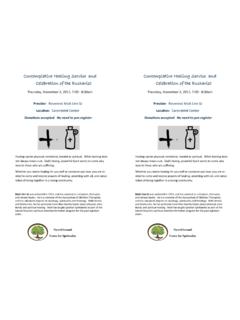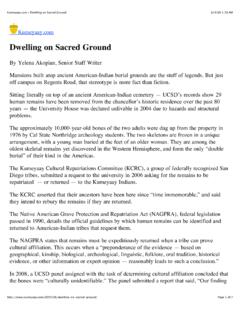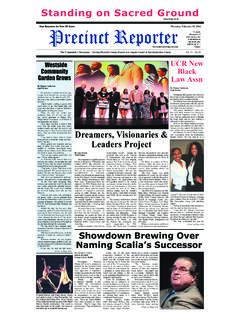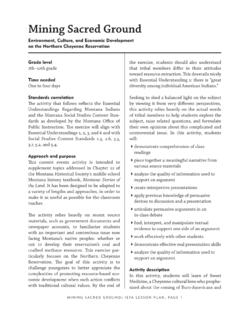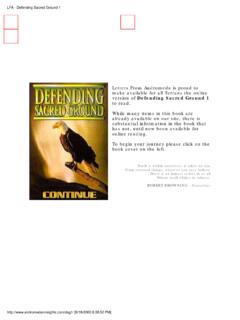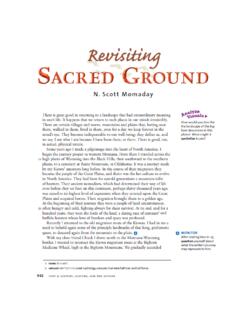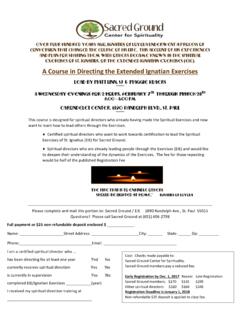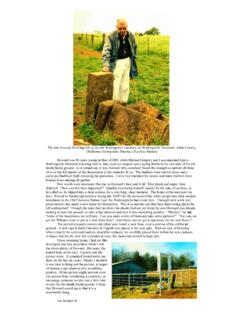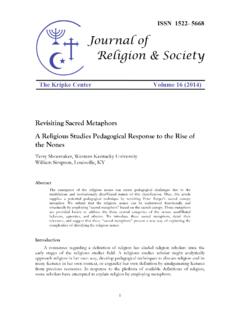Transcription of StandingOnSacredGround
1 The Project & Director s Statement 2 Initial Questions & Learning Objectives 4 Viewing Guide Ten Questions 9 Classroom Questions and Activities Organized by Theme 11indigenous leadership 11history and laws 13competition for resources: water and dams 15salmon: an endangered species 18resistance strategies 19 About the sacred Land Film Project 21 Additional Resources 23 Common Core Standards 25 Pilgrims and Tourists 2 About the ProjectStanding on sacred ground is a four-part documentary film series about indigenous people around the world facing threats to land they consider sacred . Each episode is 55 minutes long and each contains stories of two native cultures. The Winnemem segment is the second half of Episode 1, Pilgrims and s StatementThirty years ago, listening to Hopi elders, I first heard the mes-sage: The environmental crisis is a spiritual crisis. The absence of a conscious connection to land and water inevitably leads to violence toward the Earth, and threatens all life.
2 It is a message I have heard since from a chorus of indigenous voices around the world, as diverse native cultures defend against attacks on their resources and on our common future. My films explore this environmental-spiritual crisis, and reveal the clash between pro-ponents of a utilitarian view of land as property and traditional communities that view land stewardship as a sacred responsi-bility. Standing on sacred ground sparks dialogue about western culture s relationship to nature and the growing global yearning to reconcile with aboriginal people. Internationally, efforts are already transforming public awareness of sacred natural sites and how revered landscapes strengthen biological and cultural diver-sity. The people in these documentaries have profoundly changed my life and worldview. Please join me in discussing the values, themes, lessons and issues they raise in the films. I look forward to hearing from you and I hope you find the films to be inspir-ing teaching tools.
3 Christopher (Toby) McLeodPilgrims and Tourists 3 How to Use This GuideThe Teacher s Guide for Standing on sacred ground is designed for high school classrooms and can be used in many subject areas, particularly social sciences and environmental studies. You will find many of the sections also appropriate for use in middle school and university settings. This guide contains discussion questions and activities to help you use the film productively before or after students watch clips from it. Many of the questions, activities and writing assignments in this guide encourage viewers of Standing on sacred ground to reflect on complex situations, not to reach definitive answers. Previewing the film will help you decide which issues and themes you want to raise in your classroom. How This Guide is Organized Questions and activities for the film are organized by theme. Select the topics that you want to focus on in your classroom rather than moving through each topic in sequence.
4 You will find suggested activities and film clips alongside discussion prompts that can be used to enhance or supple-ment your in-class discussions of the film s to Teachers: The Run4 SalmonFrom September 9 to 23, 2017, the Winnemem Wintu Tribe of northern California will follow the traditional upstream migra-tion course of native Sacramento River winter-run Chinook salmon. From the shores of San Francisco Bay up the Sacramento River valley to the waters of the McCloud River south of Mt. Shasta, participants will walk, boat, bicycle, run and ride horses along 300 miles of waterways where the endangered salmon historically have returned to spawn after years at the Winnemem segment from Standing on sacred ground (29 minutes).Subject AreasActivism American Studies Anthropology Climate Change/Global Warming Environment Environmental Ethics Environmental Justice Geography Global Issues Health Human Rights Humanities Indigenous Peoples Leadership Native Americans Recreation Religion Science Te chnolog y Society Sociology WaterPilgrims and Tourists 4 INITIAL DISCUSSION QUESTIONS AND ACTIVITIESYou may choose to engage students with these discussion prompts before viewing the film.
5 Learning Objectives: Before Viewing the Film Understand what is meant by sacred and sacred ground . Reflect on your own attitudes about places that have been significant in your life. Explain why places have different meanings for different people. Describe what might make a place have special or spiritual value for someone. Identify influences on your own personal value is sacred ?The following prompts and activities can help guide students exploration of the concept of sacred . Has a place or experience ever changed you? Ask students to discuss their own experiences, and guide the class to draw parallels and distinctions between each other s experiences. Provide definitions of the word sacred (see box). sacred Merriam-Webster Dictionary1: dedicated or set apart for the service or worship of a deity; devoted exclusively to one service or use (as of a person or purpose) 2: worthy of religious veneration; entitled to reverence and respect. 3: of or relating to religion: not secular or profane.
6 4: highly valued and important. Oxford English Dictionary1: connected with God (or the gods) or dedicated to a reli-gious purpose and so deserving veneration. 2: (of writing or text) embodying the laws or doctrines of a religion. 3: regarded with great respect and reverence by a particular religion, group, or individual. Pilgrims and Tourists 5 sacred natural site: Areas of land or water having special spiritual significance to peoples and communities. Many traditional indigenous commu-nities throughout the world have given a special status to natural sites such as mountains, volca-noes, rivers, lakes, springs, caves, forest groves, ponds, coastal waters and entire islands. Many of these have been set aside as sacred places. The reasons for their sacredness are diverse. They may be perceived as abodes of deities and ancestral spirits; as sources of healing water and medicinal plants; places of contact with the spiritual realm, or communication with a more-than-human reality; and sites of revelation and transformation.
7 They are sometimes the burial grounds of ancestors, places of pilgrimage, the locale of a tem-ple, shrine or church, or sites associated with special events, saints and spiritual leaders. (from sacred Natural Sites: Guidelines for Protected Area Managers, Robert Wild and Christopher McLeod, Editors, 2008)You can read more about how to define sacred sites at What Is a sacred Site? on the sacred Land Film Project s is sacred ground ?The following prompts and activities can help guide students exploration of the concept of sacred ground . Has a place or experience ever changed you? Ask students to discuss their own experiences, and guide the class to draw parallels and distinctions between each other s experiences. What makes a place sacred ? Encourage students to con-sider places they themselves might consider to be sacred : What do these places have in common? After watching segments of the film revisit this question and ask students what the sacred places depicted in the films have in questions to go deeper: Are there places that you would be sad to see changed or destroyed?
8 What does it feel like to be in these places? Are there places in nature that are special to you? How were you introduced to these places? How do you experi-ence these places? Other possible words to explore as a class include Holy Land, hallowed ground , consecrate. What is the cultural purpose or function of a sacred place? What is its value? Places considered sacred could include a cemetery, a bat-tlefield (consecrated or hallowed ground ) or a place where a historic or legendary event took place. Examples include Gettysburg and 9/11 ground Zero in Manhattan. (See box at right.) Why might people view these places as sacred ? How is that different from a place in nature where one goes to pray or receive instruction from nature, God or the spirit world? What is the difference between a place made sacred by human events that happened there as compared to a place of power respected because of human perceptions of what is divine?Pilgrims and Tourists 6 Exploring ValuesValues are the basis for ethical action and they inform and guide us.
9 Values vary across cultures and individuals and are usually aligned with belief systems including ethical or moral values, doctrinal/ideological (religious/political) values, social values and aesthetic values. Qualities or things we value might include spirituality, respect, honor, relationships, family, security, wealth, status, safety, experience, wisdom, language, humility, reciprocity, sharing and more. It is important for students to recognize that they all enter the classroom with different value sets, and none is more valid than another. How do you think your language, religion, gender, socioeconomic status and geographic location have influenced your values? What do you value most deeply? Indigenous values are often taught through story. The Onondaga people of New York were instructed long ago by a visitor called The Peacemaker to base all decisions on their effect seven generations in the future. Is this an effective way to teach a value in this case: always consider the future ?
10 Creating a values chart can help students better understand vari-ous belief systems and provides a basis for understanding and discussing conflicting values. When discussing value sets, it is critical not to suggest that some values are better than others. Have students list and discuss: Some of their personal values The values of capitalism Judeo-Christian values Add values of indigenous peoples as you watch the students: Where are there overlaps, similarities or differ-ences? Do you see any values in direct conflict with each other? ActivityPilgrims and Tourists 7 Property ownership and religious freedom are two core American values. The films show multiple examples of these two values com-ing into conflict. What is the value of property ownership? What is the value of religious freedom? Ask students to create argu-ments in support of each value. Ask students to imagine a situation in which someone s private property has religious significance to someone else.

